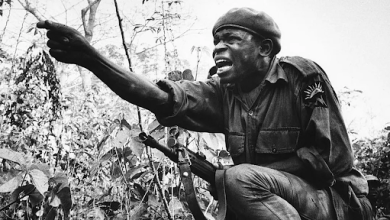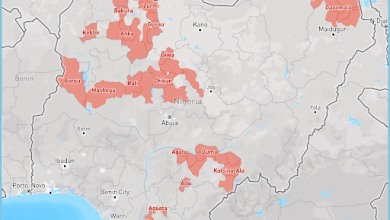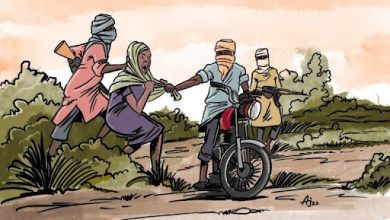
The latest incident of drone interception, when Somali National Army (SNA) forces shot down two reconnaissance drones in the Ceel Dheer district of Galgaduud region on Feb. 15, adds to a pattern of terrorists in Africa using unmanned aerial vehicles (UAVs) for their operations.
This was not the first time Al-Shabaab’s use of drones would become public knowledge. In November 2022, propaganda photosets from the terror group claimed to have used US-made ScanEagle drones to prepare an attack on a United States Manda Bay military base in Kenya that happened in 2020 and led to the death of an American military official and a contractor.
Drones have become a vital tool valued by security forces and terrorist groups alike in recent years. Militaries across Africa have invested in a mix of drone technology from across the globe. According to the Africa Defense Forum, the lightweight, commercially available drones favoured by Al-Shabaab and other terrorist groups come from China. However, the one used in the 2020 attack was said to be possibly seized from the Kenyan forces, which used it for aerial counter-terrorism operations.
Following the example of the Islamic State (IS), which carried out several drone attacks in Iraq and Syria, there’s an overwhelming fear that as drones become more available in Africa, especially in counter-terrorism operations, terrorists in the region could confiscate heavy-load drones and them to deliver explosives.
Between 2015 and 2017, IS modified quadcopter drones to drop munitions onto coalition forces on the ground and conducted several kamikaze attacks in its operational areas. There were 256 recorded instances of IS using UAVs in Iraq and Syria between 2014 and 2020.
Experts warn that Al-Shabaab and other terrorist groups, such as the Islamic State West African Province (ISWAP), could use similar tactics to target civilian and military infrastructure. Already, major terror organisations in Africa have used drones for intelligence, surveillance, and reconnaissance. In July 2022, in the town of Gubio, Nigeria, ISWAP used a surveillance drone to survey the location of a Nigerian military convoy before ambushing them.
The Islamic State in Mozambique used drones in May 2020 to identify targets in the Mocimboa de Praia attacks. The following year, it used drones again to gather intelligence for its attack on Palma. A month later, the Islamic State in the Greater Sahara (ISGS) also carried out a drone-assisted attack on security forces in Mali.
Terror in the skies
UAVs are increasingly becoming the weapon of choice for terrorists in Africa. After the defeat of IS in Iraq and Syria, a large number of its fighters migrated to Africa, bringing with them their technical skills and knowledge of operating drones. These flying machines, which can be remotely controlled or programmed to fly autonomously, offer terrorists a range of capabilities that can enhance their planning and execution of attacks.
From surveillance and reconnaissance to kamikaze strikes and propaganda, drones pose a serious and evolving threat to security and stability on the continent. For example, in 2022, ISGS used drones to stage a “complex and coordinated” attack that killed over 40 Malian soldiers in the Gao region.
Although no evidence of using UAVs for offensives was found in the Sahel, several propaganda videos from different terrorist groups operating in the region, such as Jama’atu Nusratil Islam Wal Muslimin (JNIM) and Al-Qaeda in Islamic Maghreb (AQIM), have shown how they used drones for propaganda videos and reconnaissance missions. As early as 2019, Algerian forces targeted AQIM and confiscated several weapons and UAVs.
One of the main advantages of drones for terrorists is their ability to provide aerial intelligence and situational awareness. By using drones equipped with cameras and sensors, terrorists gather information about their targets, monitor enemy movements, and scout for vulnerabilities. This helps them plan and coordinate their attacks more efficiently.
It’s been suggested that ISWAP might have even more sophisticated drones than the Nigerian Army. One report explained that it was “probable that Islamic State core transferred its technological know-how to its West African province (ISWAP) through direct exchanges between fighters in Libya or Nigeria, or through encrypted online communications”.
In 2022, ISWAP claimed to have used drones to spy on the positions of the Nigerian army and the Multinational Joint Task Force (MNJTF) in the Lake Chad Basin region. The group released a video showing aerial footage of military camps and vehicles. The propaganda video was intended to demonstrate the group’s capabilities and intimidate its adversaries.
Another example is Al-Shabaab, which has repeatedly used drones to conduct surveillance on the African Union Mission in Somalia (AMISOM) and the Somali National Army (SNA) bases and convoys. The group has also used drones to monitor the movements of foreign dignitaries and humanitarian workers in the country.
However, the use of drones for suicide bombings or kamikaze attacks against targets poses the biggest threat. By attaching explosives or other payloads to drones, terrorists can turn them into flying bombs that can be remotely detonated or programmed to crash into targets. This allows them to strike targets that are otherwise difficult or impossible to reach, such as fortified or high-security locations, or to cause maximum damage to civilians.
The use of drones in this manner can increase the lethality and unpredictability of terrorist attacks, as well as the difficulty of detecting and intercepting them. It can also create a psychological impact on the target population, as drones can induce fear and panic among civilians and security personnel.
While there have been no confirmed cases of drone-based kamikaze attacks by terrorists in Africa, there have been several instances of such attacks elsewhere in the world. For instance, in 2017, IS claimed to have used drones to attack Russian and Syrian forces in Syria, killing and injuring several soldiers and damaging equipment.
In 2018, two drones laden with explosives were used in an attempted assassination of Venezuelan President Nicolas Maduro during a military parade in Caracas. In 2019, Houthi rebels in Yemen claimed to have used drones to attack oil facilities in Saudi Arabia, causing massive fires and disrupting global oil supplies.
Technical challenges
Despite the potential benefits of drones for terrorists, they may also face several challenges in acquiring and operating them. These include the availability and affordability of drones and their components, the technical skills and expertise required to operate and maintain them, and the vulnerability of drones to interference and countermeasures.
Drones and their components, such as batteries, cameras, and GPS devices, may not be easily accessible or affordable for terrorists in Africa. While commercial drones are becoming more widespread and cheaper, they may still be beyond the reach of some terrorist groups, especially those operating in remote or impoverished areas. Moreover, some countries in Africa have imposed restrictions or bans on the importation, sale, and use of drones, making it harder for terrorists to obtain them.
However, places like the Lake Chad Basin region, where ISWAP and Boko Haram operate, and Sahel, where AQIM and ISGS operate, may likely not face this challenge as the region has a large porous border area and ungoverned spaces where drones can be smuggled or transported across countries. Moreover, the region has a weak and fragmented security apparatus, which may lack the capacity and coordination to detect and respond to drone threats.
Another challenge is the technical skills required to operate the drones. While some commercial drones are relatively easy to use, others may require more sophisticated training to fly and control them. Additionally, terrorists may need to customise their drones to suit their needs and objectives, such as attaching explosives or other payloads, which may entail additional risks.
Although this can be challenging for terrorist organisations such as AQIM, it’s not as challenging for ISWAP, IS-Mozambique, and other IS affiliates. This is because many members of IS Central have moved to Africa and brought with them technical knowledge, although not on a frightening scale.
The biggest challenge for the terrorists, however, is that drones are vulnerable to interference and countermeasures that can disrupt or disable their functionality. For example, they can be jammed or spoofed by electronic warfare devices that can interfere with their communication or navigation systems. They can be shot down or captured by anti-drone weapons, such as guns, nets, or lasers. Drones can also be hacked or hijacked by cyberattacks that can take over their control or access their data.
Security analysts observing the trend are worried and have urged the authorities to step up their game in tackling the threats.
“It’s a very serious development,” Chidi Omeje told VOA last year. “It’s something that the subregion military groups should take particular interest on to see how they can be on top of the situation.”
Support Our Journalism
There are millions of ordinary people affected by conflict in Africa whose stories are missing in the mainstream media. HumAngle is determined to tell those challenging and under-reported stories, hoping that the people impacted by these conflicts will find the safety and security they deserve.
To ensure that we continue to provide public service coverage, we have a small favour to ask you. We want you to be part of our journalistic endeavour by contributing a token to us.
Your donation will further promote a robust, free, and independent media.
Donate HereStay Closer To The Stories That Matter




